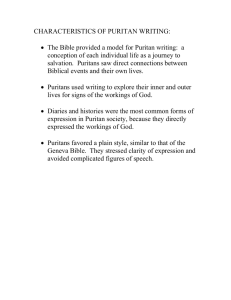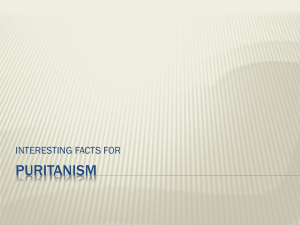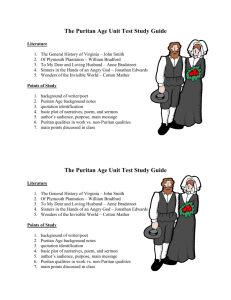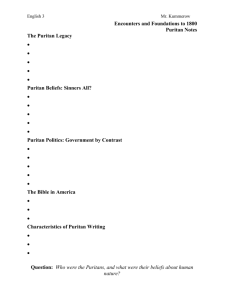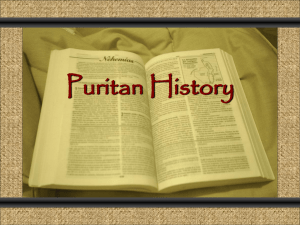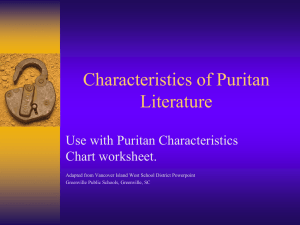Puritans in America
advertisement
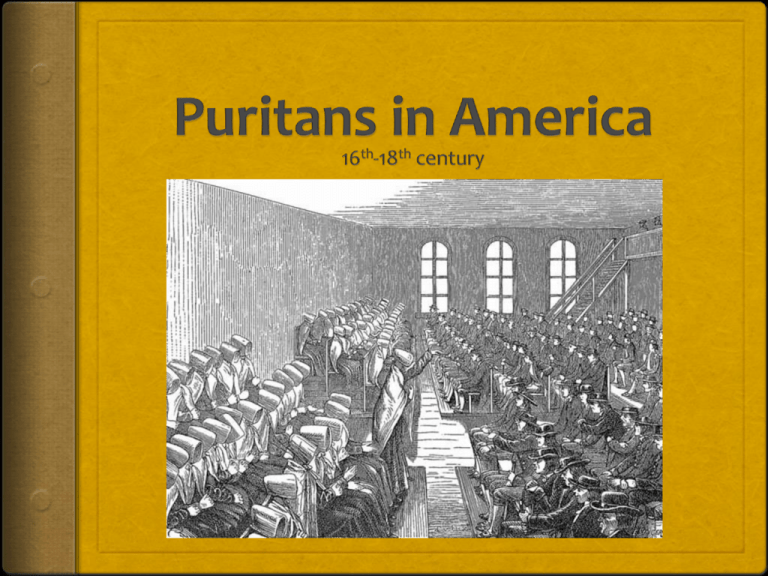
The Times Have Changed Haven’t They? Change In the 17th century, Puritan colonists profoundly changed life in North America. Their impact in many ways is still felt today. I. History of Puritans in America A. Arrival motivated by political unrest in England 1. 2. King Charles forbid change in Church of England Puritans wanted to “Purify” church (hence Puritan) I. History of Puritans in America (cont.) B. Fled England for Massachusetts Bay 1. Colonies at Plymouth, Salem, and Cape Ann 2. Set up schools, such as Yale and Harvard I. History of Puritans C. Decline came fast in end of 17th century 1. Salem Witch Trials undermined church 2. Evolving philosophy after “great awakenings” 3. Modern Presbyterians and Unitarians are the remnants of Puritans II. Puritan Beliefs A. Religion based strongly on teachings of John Calvin, which had five principles. 1. “Total Depravity” – mankind will always choose evil over good II. Puritan Beliefs (cont.) 2. “Unconditional Election” – you are chosen to be saved or damned II. Puritan Beliefs (cont.) 3. “Limited Atonement” – Jesus only died for the sins of the chosen 4. “Irresistible Grace” – if you are chosen, the Holy Spirit will force you to do good 5. “Perseverance of the Saints” – Satan cannot reclaim the souls of the chosen II. Puritan Beliefs (cont.) B. Man and his accomplishments exist solely for the Glory of God C. If Hard Work results in success, it is a sign that you are one of the “elected.” D. Government should be a theocracy, meaning church and government are one (decisions based on religious belief). III. Puritan Literature A. Sermons 1. 2. Intent is to frighten listeners Vivid images of suffering in hell B. Historical Narratives 1. 2. Relay historical information Lace story with religious significance C. Poetry (always religious) IV. “Sinners in the Hands of an Angry God” (1741) A. Author: Jonathan Edwards 1. 2. B. Style 1. 2. 3. C. Puritan preacher Would later reject Puritanism during Great Awakening Late Puritan Sermon Rich in vivid imagery of human suffering Extensive use of metaphor Significance 1. 2. Most widely studied piece of Puritan literature Reflects Calvin’s principles of “Total Depravity” and “Limited Atonement,” but contradicts those values in conclusion (reflecting changing values) V. “Of Plymouth Plantation” (1667) A. William Bradford 1. 2. B. Style 1. 2. C. Governor of Plymouth Plantation Led colonists on difficult journey on Mayflower Historical narrative – realistically relays events of early settlement Bradford uses real events to teach religious lessons, a sort of “disguised sermon.” Significance 1. 2. One of the only existing documents about early Puritan settlements Shows how religion dominated every aspect of Puritan life VI. “A Narrative of the Captivity” (approx 1711) A. Mary Rowlandson 1. 2. Early American colonist who lived in Salem Spent 11 weeks as a captive of Indians B. Style 1. 2. 3. C. Historical narrative Teaches religious lessons, a sort of “disguised sermon.” Compares herself to Job, and to the Israelites. Significance 1. 2. Enormously popular, it served to motivate further conversion of Indians Rare glimpse at early colonial life in America Big Questions (because it has to matter, right?) 1. How are Puritan religious values and beliefs seen in their literature? 2. What place, if any, do Puritan values still have in today’s world?
